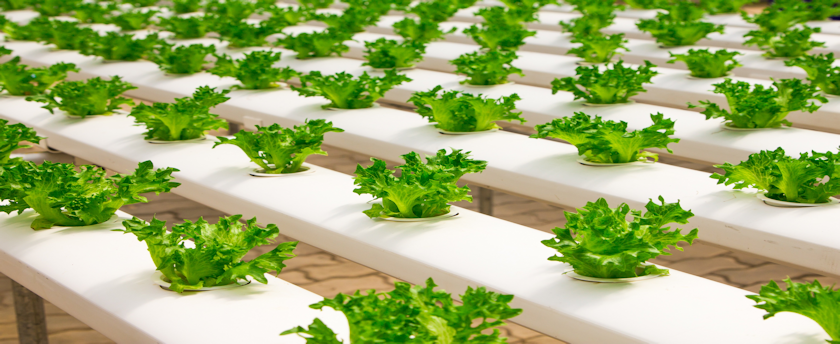
Find a way to take the weather completely out of farming in a greenhouse and use computers to control the temperature, light, water and nutrients, thus taking extreme weather out of the agricultural equation, even take the variables out of mother nature and you have:
Controlled Environment Farming
With the advent of new and improved lighting, hydroponic,aeroponic, and various soil less culture technologies that use less resources and produce more consistent products from a visual as well as nutritional standpoint, controlled environment farming is becoming more competitive with conventional methods.
Our systems incorporate alternative energy to power the facility and we only use locally sourced recyclable building products. With our systems you can grow produce in a competitive manner with traditional farming methods and raise a "true organic" product.
Controlled Environment
Controlled environment agriculture (CEA)/greenhouse vegetable production is one of the most exacting and intense forms of all agricultural enterprises. In combination with greenhouses, hydroponics or soilless cultivation is becoming increasingly popular. It is high technology and can be capital intensive. CEA is highly productive, conservative of water and land and protective of the environment. There are many types of CEA systems. Not every system is cost effective in each location. While the techniques of hydroponic culture in the tropics may be quite similar to those used in deserts and temperate regions of the world, the greenhouse structures and methods of environmental control can differ greatly. Computers today operate hundreds of devices within a greenhouse by utilizing dozens of input parameters to maintain the most desired growing environment. The technology of controlled environment agriculture is changing rapidly with systems today producing yields never before realized.
Controlled-environment agriculture (CEA) is any agricultural technology that enables the grower to manipulate a crop's environment to the desired conditions. CEA technologies include greenhouse, hydroponics, aquaculture, and aquaponics. Controlled variables include temperature, humidity, pH, and nutrient analysis.
In research, CEA is useful for isolating specific environmental variables for closer study. For example, researchers may study photosynthesis by comparing a crop from a greenhouse with special pane tinting with one that is not tinted. The advantage is that all other factors can be kept constant, reducing the incidence of another influence on the experiment.
A February 2011 article in the magazine, "Science Illustrated" states, :In commercial agriculture, CEA can increase efficiency, reduce pests and diseases, and save resources.... Replicating a conventional farm with computers and LED lights is expensive but proves cost-efficient in the long run by producing up to 20 times as much high-end, pesticidee-free produce as a similar size plot of soil. Fourteen thousand square feet of closely monitored plants produce 15 million seedlings annually at the solar-powered factory. Such factories will be necessary to meet urban China's rising demand for quality fruits and vegetables
Vertical Farming
Vertical farming is a concept that argues that it is economically and environmentally viable to cultivate plant or animal life within skyscrapers, or on vertically inclined surfaces. The idea of a vertical farm has existed at least since the early 1950s and built precedents are well documented by John Hix in his canonical text "The Glass House"
.Irrespective of their origins, there are three classifications debated by contemporary scholars.
1) The phrase 'vertical farming' was coined by Gilbert Ellis Bailey in 1915. In his book 'Vertical Farming', Bailey defined the earliest meanings and methods of 'vertical farming':
"Vertical Farming", to coin a name, is the keynote of a new agriculture that has come to stay, for inexpensive explosives enable the farmer to farm deeper, to go down to increase area, and to secure larger crops. Instead of spreading out over more land he concentrates on less land and becomes an intensive rather than an extensive agriculturist, and soon learns that it is more profitable to double the depth of his fertile land than to double the area of his holdings, and he learns that his best aid and servant in this work is a good explosive. Peace congresses demand that swords be turned into pruning hooks. The farmer is busy turning explosives from war to agriculture, from death dealing to life giving work.
2) The second category of vertical farming falls under the concepts proposed and built by architect Ken Yeang developed at least ten years before Despommier. Yeang proposes that instead of hermetically sealed mass produced agriculture that plant life should be cultivated within open air, mixed-use skyscrapers for climate control and consumption (i.e. a personal or communal planting space as per the needs of the individual). This version of vertical farming is based upon personal or community use rather than the wholesale production and distribution plant and animal life that aspires to feed an entire city. It thus requires less of an initial investment than Despommier's 'The Vertical Farm'. However, neither Despommier nor Yeang are the conceptual 'originators'. Yeang was not the inventor of 'vertical farming' in skyscrapers either.
3) The third category 'vertical farming' was made by American ecologist Dr. Dickson Despommier. Despommier argues that 'vertical farming' is legitimate due to environmental reasons. He claims that the cultivation of plant and animal life within skyscrapers will produce less embedded energy and toxicity than plant and animal life produced on natural landscapes. He moreover claims that natural landscapes are too toxic for natural, agricultural production, despite the ecological and environmental costs of extracting materials to build skyscrapers for the simple purpose of agricultural production.
Vertical farming according to Despommier thus discounts the value of natural landscape in exchange for the idea of 'skyscraper as spaceship'. Plant and animal life are mass produced within hermetically sealed, artificial environments that have little to do with the outside world. In this sense, they could be built anywhere regardless of the context. This is not advantageous to energy consumption as the internal environment must be maintained to sustain life within the skyscraper.
Despommier's concept of 'The Vertical Farm' emerged in 1999 at Columbia University. It promotes the mass cultivation of plant and animal life for commercial purposes in skyscrapers. Using advanced greenhouse technology such as hydroponics and aeroponics, the skyscrapers could theoretically produce fish, poultry, fruit and vegetables.
While the concept of stacked agricultural production is not new, scholars claim that a commercial high-rise farm such as 'The Vertical Farm' has never been built, yet extensive photographic documentation and several historical books on the subject suggest that research on the subject was not diligently pursued. New sources indicate that a tower hydroponicum existed in Armenia prior to 1951.
Proponents argue that, by allowing traditional outdoor farms to revert to a natural state and reducing the energy costs needed to transport foods to consumers, vertical farms could significantly alleviate climate change produced by excess atmospheric carbon. Critics have noted that the costs of the additional energy needed for artificial lighting, heating and other vertical farming operations would outweigh the benefit of the building's close proximity to the areas of consumption


